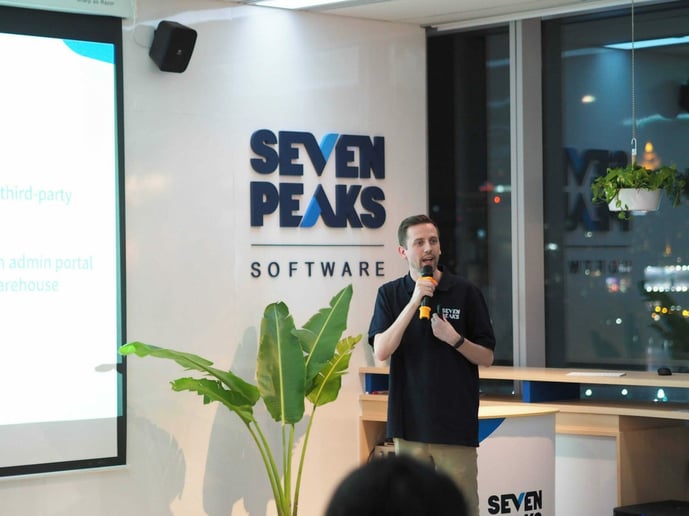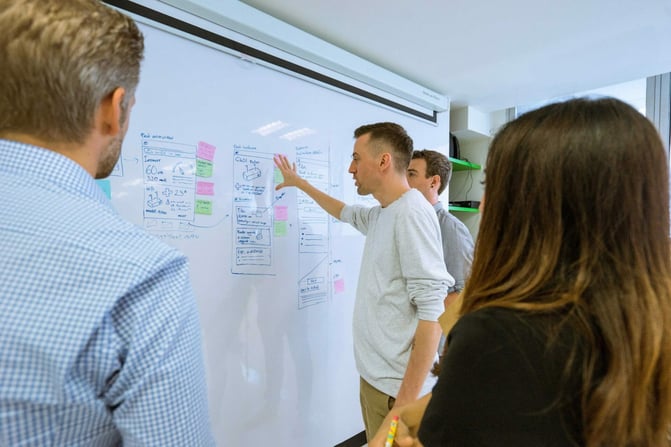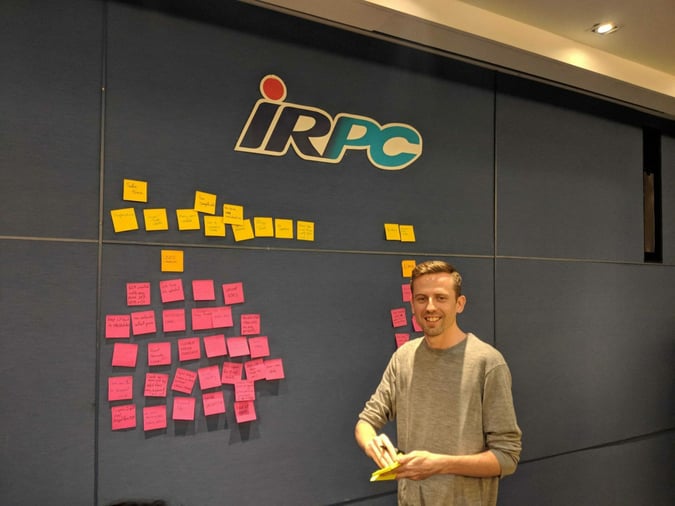Share this
The story behind my amazing journey.
by Seven Peaks on Feb 17, 2022 10:49:00 AM
This is Craig – Lead UX & Product Manager @ Seven Peaks Software

About Craig Reville
As a lead UX and product manager, Craig has worked with startups, small medium and large companies, corporations such as RHB, IRPC and BSkyB as well as his own non-software based ventures across much of the world.
Most recently Craig has been undertaken the challenge of transitioning across to Product manager on top of his Lead UX role, where he helps build the the clients vision, and make it a reality while advising on best practices and providing essential support to teams.

Introduction
“My journey was not intentional, it was all by accident”
Our Lead UX and Product Manager, Craig, who has travelled the world, working in different cultures and environments, shares his insights on what he learned from his experience.
Before Thailand
In the early years, Craig started out as a Backend developer, focusing on data analysis and didn’t yet have his journey figured out. He tells us that he felt like he didn’t have a path, unlike his friends whom had a clear direction and a clear goal.
“They knew exactly where they wanted to be and what they wanted to do, I didn’t, I just knew I was good at something and it interested me to learn more” – Craig explains.
Craig held a number of roles since his humble beginnings, including Front End Developer, Designer and even assisting companies as an external consultant.
This fascinating background and mix of disciplines allowed Craig to travel and pick up the necessary experiences & skills to end up here, with us at Seven Peaks.
The adventure begins
Before joining Seven Peaks, Craig spent time working and traveling across areas of Thailand, this is where some of his more adventurous experiences come from and helped shape his future.
“After arriving in Thailand, I had a number of accidents and a few specific events changed everything for me, I eventually made it back home but things didn’t add up so returning to Thailand was the only thing that made sense.” – Craig continued.
“After arriving back in Thailand, I took a few jobs and completely misjudged my role, misjudged the requirements and felt that I needed to step back and re-evaluate my situation”
During this period Seven Peaks was a smaller agency, looking to scale, expand and begin shaping its teams, such as the design team and things just seemed to fit, as Craig explains, his first day with the company was far from normal.
Having not officially met his team yet, Craig was brought on as a contractor and sent to work on a large scale project in the capacity of a Senior UI Designer.
“I called Jostein on the Friday and told him I just left my previous company, shortly after he told me to meet everyone at the airport on Monday morning at 3am, unusual beginning to things but I thought, why not, sounds fun.”

From Designer to PM
For the first 6-8 months, Craig contracted for Seven Peaks while working on the digital transformation project, pushing hard to meet tight deadlines, client requirements and ensuring to always produce high quality work, it was clear that he would become an asset to the company, but this was just the beginning.
Fast forward a year, Craig had already helped Andy (Design Manager) to carve a name in the industry for Seven Peaks as a trusted Design agency who work hard and fast, and the transition was already beginning, from Designer into a Product Manager as he gained more knowledge and experience on projects.
“As more and more clients came in, I started to lead the design aspect more but with my technical background it made sense to be part of that process too.
I would often start by looking at the technical aspects of things, which allowed me and the team to run projects efficiently.
I started growing more towards the purpose, the objectives which is more product management based, which is where I am now.” – shared Craig.
Craig expressed his interests in developing his skills to his manager, team, during appraisals and started pro-actively learning the role in order to demonstrate his thirst for change. This process wasn’t easy and took time as Craig took on more roles, more duties, more learning in order to achieve this milestone in his life.
“You have set set milestones for your next step in the career, for me that was ‘what’s next after design? To become a great Lead? To become a skilled PM?’ and then work out afterwards, how you get there, but mainly it should be with the help and support of your team, managers and company. “
Have you ever wondered what the difference between a project manager and a product manager / owner?
“There’s a difference. Project management is an older format of working, it’s all about managing the working teams, very hands on.
Product Management (PM, PO) is stepping back and looking at it from an objective base, working with the client to build a product that makes sense to the business and audience, and making sure that we achieve the goals of the business and product alike; which is very different way of thinking and working.
Project-based is all about the tasks, daily, weekly, monthly tasks, and achieving it on time in based on time formatted estimations.
Product-based is all about objectives, goals, effort vs. impact, and accomplishing the product goals.
It makes sense to move up into the product level, and that’s the stage that Seven Peaks Software is right now; to bring in more product based teams.” – explained Craig.
 |
 |

A career-changing experience
Progress – the word that Craig stresses to be very important. To get to where you want, and to be the best you can be, he suggests to strive for greater progress for yourself and for those around you.
“If I stay in the same position, I will not be making progress for anyone. I will only be maintaining and while that sounds great, we’re not making incremental improvements.
What we need to do is look at where we are and ask, what is next? Where do I need to be, what do I want to be?
I’ve spent most of my life feeling uncomfortable in my work life, it’s the feeling of being an imposter, like you don’t deserve this, like you might not know what you’re doing, that’s because you’re doing something new, something challenging and that is exactly when you are learning the most.
“… that’s because you’re doing something new, something challenging and that is exactly when you are learning the most” – Craig
I have always kept away from being in that position where I feel over-comfortable, it’s a normal feeling I guess, but it means I’ve stopped pushing and learning.
To always be changing, is definitely something that I urge you to do when going forward in your career.” – stated Craig.
Craig emphasizes that constant positive constructive change and new experiences allow for further growth and learning – as you’re not only learning for yourself, but you’re also learning in order to lead others, to teach them, to mentor your colleagues, and to help your company grow, which can be just as important.

The key takeaway
Craig told us that his biggest takeaway of his experience, however clićhe it is, that it’s never too late to find the path you belong on, you just have to keep pushing and learning and the path will become clearer.
“It’s one of those things that people never teach.
If you remember back to University, they told us to write about ourselves and our goals in life and send it as part of our applications, mine was blank, I asked them how would I know my path if I haven’t even begun yet? No one could explain this to me.
Now I understand that in fact, if you know you know, and if you don’t, don’t worry about it, pick something you’re passionate about and get good at that, and another path will open up … TAKE IT!
At some point in the future people will ask you about you life, how did you manage to do all these things, how did you know what you wanted to do, and you can tell them, I didn’t know, you gotta let go and trust in yourself to always make it through.
” – quoted Craig.
Craig’s realization of working life isn’t unusual but it helped shape the person he is today, learning how hard work life is, the dedication required.
Craig notes that a large number of his friends dropped out of university in the final years, some were doubting their path, others understood that it wasn’t for them and some simply didn’t have the passion for it, they were meant for something different and that’s ok.
“I’m learning, even now, that you got to embrace what you’re doing and if you don’t like it, you can change it. No one expects you know everything and be perfect, except from yourself and that’s the biggest enemy you have.” – said Craig.
“… embrace what you’re doing and if you don’t like it, you can change it”. – Craig

Grow with us
Absolutely no regrets – Craig has now spent over a decade working in Thailand, with half of this time in Seven Peaks learning and growing and it was, as Craig puts it, the best accident to happen to him, he’s been leading the UX efforts, setting standards and running Product based projects.
“From a design point of view, it is about making sure that the new designers we’re bringing into the team become part of the product, and part of that team – that we have products well catered for and managed and that we’re helping them up-skill and gain new essential experience.
This industry [software development & technology] has become extremely customer centric, moving towards Customer Experience, so being extremely flexible can help you succeed. I believe that in this industry, we should be as flexible as possible.
This doesn’t mean you give up your values, or your standards, it means you learn to adapt and control it so you are the one that begins to lead and you are the one people follow.” – expressed Craig.
As Craig explains, there are pros and cons to everything, being too flexible can impact your personal life, being too rigid can affect your working life, you have to learn how to get the perfect balance for you.
Craig quoted that Seven Peaks’ flexibility has allowed him and his team to grow, adapt, and up-skill themselves, taking on new challenges are not afforded in other companies and agencies.
Interested in following Craig’s path to re-locating and working with us in Thailand? Visit our Careers page with new open positions that are waiting to be filled!
Share this
- FinTech (13)
- Career (12)
- Expert Spotlight (12)
- Thought Leadership (12)
- Product Growth (9)
- Software Development (9)
- Data and Analytics (7)
- Product Design (7)
- Digital Product (6)
- AI (5)
- Cloud (5)
- Data (5)
- Design Thinking (5)
- InsurTech (5)
- QA (5)
- Agile (4)
- CSR (4)
- Company (4)
- Digital Transformation (4)
- Financial Inclusion (4)
- JavaScript (4)
- Seven Peaks Insights (4)
- Trend (4)
- UX Design (4)
- UX Research (4)
- .NET (3)
- Android Developer (3)
- Android Development (3)
- Azure (3)
- Banking (3)
- DevOps (3)
- IoT (3)
- Product-Centric Mindset (3)
- Service Design (3)
- CDP (2)
- Cloud Development (2)
- Customer Data Platform (2)
- E-wallet (2)
- Expat (2)
- Hybrid App (2)
- Kotlin (2)
- Product Owner (2)
- Software Tester (2)
- SwiftUI (2)
- UI (2)
- UX (2)
- UX Writing (2)
- Visual Design (2)
- iOS Development (2)
- .NET 8 (1)
- 2023 (1)
- 2025 (1)
- 4IR (1)
- 5G (1)
- API (1)
- Agritech (1)
- AndroidX Biometric (1)
- App Development (1)
- Azure OpenAI Service (1)
- Backend (1)
- Brand Loyalty (1)
- CI/CD (1)
- Conversions (1)
- Cross-Platform Application (1)
- Dashboard (1)
- Digital (1)
- Digital Healthcare (1)
- Digital ID (1)
- Digital Landscape (1)
- Engineer (1)
- Expert Interview (1)
- Fiddler (1)
- Figma (1)
- Financial Times (1)
- GraphQL (1)
- Hilt (1)
- IT outsourcing (1)
- KYC (1)
- MVP (1)
- MVVM (1)
- Metaverse (1)
- Morphosis (1)
- Native App (1)
- New C# (1)
- Newsletter (1)
- Node.js (1)
- Payment (1)
- Platform Engineer (1)
- Platform Engineering Jobs (1)
- Platform Engineering Services (1)
- Product Discovery (1)
- Project Manager (1)
- Rabbit MQ (1)
- React (1)
- ReactJS (1)
- Stripe (1)
- Super App (1)
- Turnkey (1)
- UIkit (1)
- UX Strategy (1)
- Web 3.0 (1)
- Web-Debugging Tool (1)
- July 2025 (1)
- June 2025 (10)
- May 2025 (2)
- April 2025 (2)
- March 2025 (4)
- February 2025 (1)
- January 2025 (3)
- December 2024 (4)
- November 2024 (2)
- September 2024 (4)
- August 2024 (3)
- July 2024 (6)
- April 2024 (1)
- March 2024 (7)
- February 2024 (14)
- January 2024 (13)
- December 2023 (9)
- November 2023 (9)
- October 2023 (2)
- September 2023 (6)
- August 2023 (6)
- June 2023 (4)
- May 2023 (4)
- April 2023 (1)
- March 2023 (1)
- November 2022 (1)
- August 2022 (4)
- July 2022 (1)
- June 2022 (6)
- April 2022 (6)
- March 2022 (4)
- February 2022 (8)
- January 2022 (4)
- December 2021 (1)
- November 2021 (2)
- October 2021 (2)
- September 2021 (1)
- August 2021 (3)
- July 2021 (1)
- June 2021 (2)
- May 2021 (1)
- March 2021 (4)
- February 2021 (5)
- December 2020 (4)
- November 2020 (1)
- June 2020 (1)
- April 2020 (1)
